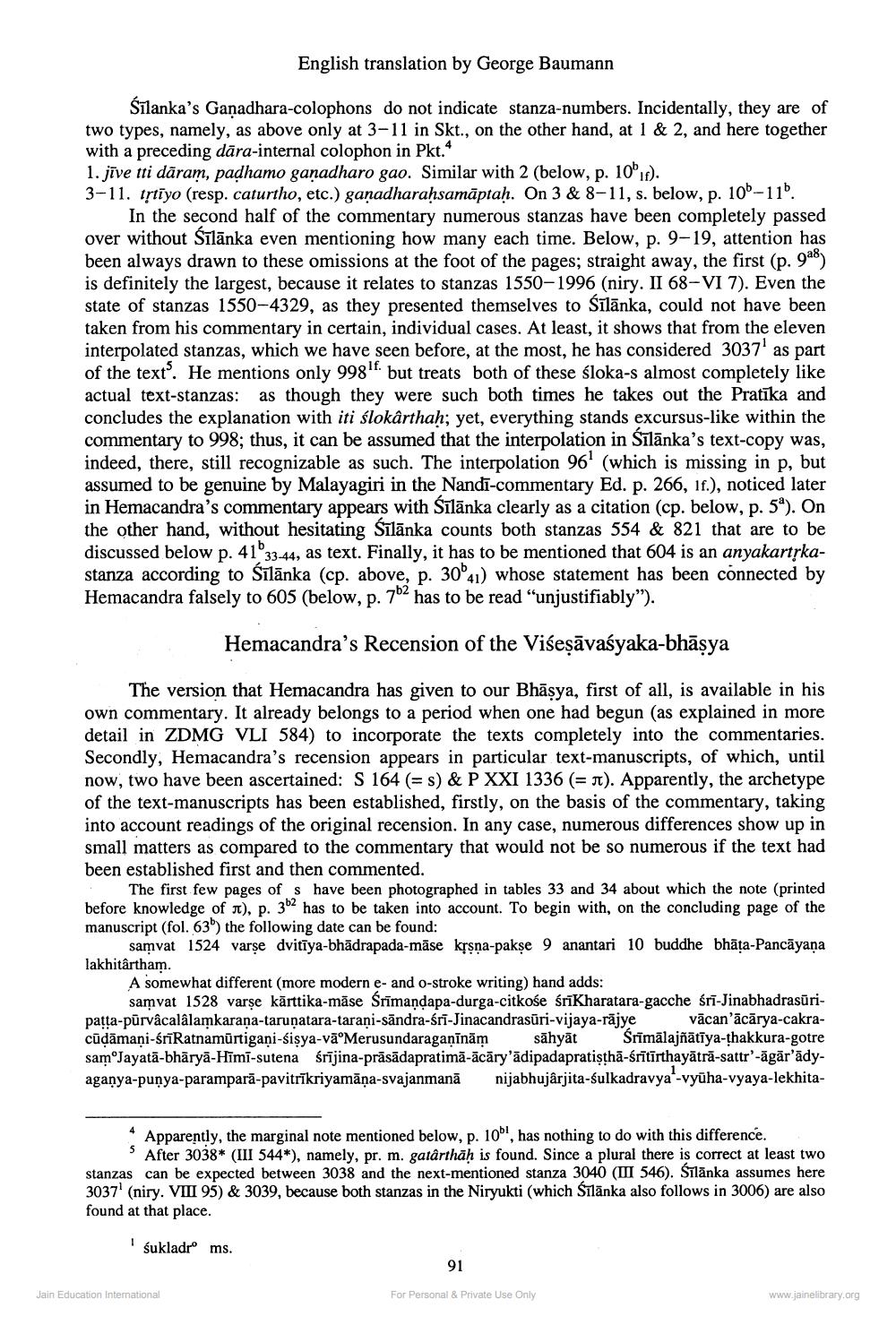________________
English translation by George Baumann
Śīlanka's Ganadhara-colophons do not indicate stanza-numbers. Incidentally, they are of two types, namely, as above only at 3-11 in Skt., on the other hand, at 1 & 2, and here together with a preceding dāra-internal colophon in Pkt. 1. jīve tti dāram, padhamo ganadharo gao. Similar with 2 (below, p. 10" 1f). 3-11. třtiyo (resp. caturtho, etc.) ganadharahsamāptah. On 3 & 8-11, s. below, p. 106-110.
In the second half of the commentary numerous stanzas have been completely passed over without Sīlānka even mentioning how many each time. Below, p. 9-19, attention has been always drawn to these omissions at the foot of the pages; straight away, the first (p. 948) is definitely the largest, because it relates to stanzas 1550-1996 (niry. II 68-VI 7). Even the state of stanzas 1550-4329, as they presented themselves to Sīlānka, could not have been taken from his commentary in certain, individual cases. At least, it shows that from the eleven interpolated stanzas, which we have seen before, at the most, he has considered 3037' as part of the text'. He mentions only 998. but treats both of these sloka-s almost completely like actual text-stanzas: as though they were such both times he takes out the Pratīka and concludes the explanation with iti ślokârthah; yet, everything stands excursus-like within the commentary to 998; thus, it can be assumed that the interpolation in Silānka's text-copy was, indeed, there, still recognizable as such. The interpolation 96 (which is missing in p, but assumed to be genuine by Malayagiri in the Nandī-commentary Ed. p. 266, 1f.), noticed later in Hemacandra's commentary appears with Sīlānka clearly as a citation (cp. below, p. 54). On the other hand, without hesitating Sīlānka counts both stanzas 554 & 821 that are to be discussed below p. 41°33-44, as text. Finally, it has to be mentioned that 604 is an anyakartykastanza according to Sīlānka (cp. above, p. 30°41) whose statement has been connected by Hemacandra falsely to 605 (below, p. 704 has to be read "unjustifiably').
Hemacandra's Recension of the Viseșāvaśyaka-bhāşya
The version that Hemacandra has given to our Bhāsya, first of all, is available in his own commentary. It already belongs to a period when one had begun (as explained in more detail in ZDMG VLI 584) to incorporate the texts completely into the commentaries. Secondly, Hemacandra's recension appears in particular text-manuscripts, of which, until now, two have been ascertained: S 164 (=s) & P XXI 1336 (= n). Apparently, the archetype of the text-manuscripts has been established, firstly, on the basis of the commentary, taking into account readings of the original recension. In any case, numerous differences show up in small matters as compared to the commentary that would not be so numerous if the text had been established first and then commented.
The first few pages of s have been photographed in tables 33 and 34 about which the note (printed before knowledge of a), p. 30 has to be taken into account. To begin with, on the concluding page of the manuscript (fol. 63') the following date can be found:
samvat 1524 varse dvitīya-bhādrapada-māse kysna-pakşe 9 anantari 10 buddhe bhāța-Pancāyaṇa lakhitartham
A somewhat different (more modern e- and o-stroke writing) hand adds:
samvat 1528 varṣe kārttika-māse Śrīmandapa-durga-citkośe śrīKharatara-gacche śrī-Jinabhadrasūripatta-pūrvâcalâlamkarana-tarunatara-tarani-sāndra-śrī-Jinacandrasuri-vijaya-rājye vācan'ācārya-cakracūļāmani-śrīRatnamurtigani-sisya-vā Merusundaraganīnām s āhyāt Srimālajñātīya-thakkura-gotre samoJayatā-bhāryā-Hīmī-sutena śrījina-prāsādapratimā-ācāry'ādipadapratisthā-śrītīrthayātrā-sattr'-āgār'ādyaganya-punya-paramparā-pavitrīkriyamāņa-svajanmanā n ijabhujarjita-sulkadravya -vyuha-vyaya-lekhita
* Apparently, the marginal note mentioned below, p. 10", has nothing to do with this difference.
After 3038* (III 544*), namely, pr. m. gatârthāh is found. Since a plural there is correct at least two stanzas can be expected between 3038 and the next-mentioned stanza 3040 (III 546). Silānka assumes here 3037' (niry. VIII 95)& 3039, because both stanzas in the Niryukti (which Śtlänka also follows in 3006) are also found at that place.
sukladro ms.
Jain Education International
For Personal & Private Use Only
www.jainelibrary.org




